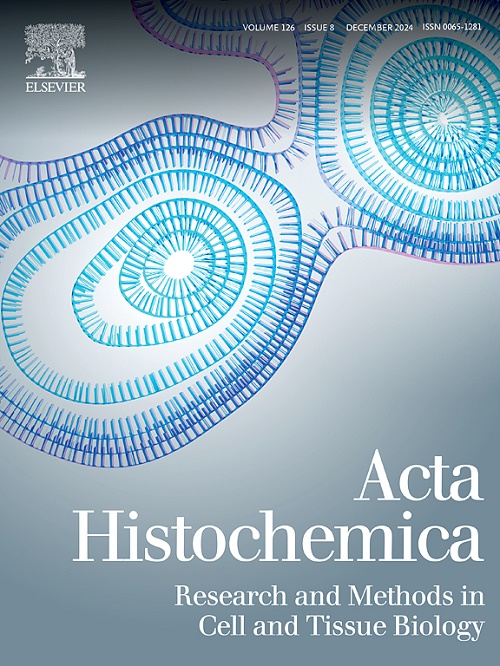Effect of chloroquine on autophagy and the severity of caerulein-induced acute pancreatitis in mice
IF 2.4
4区 生物学
Q4 CELL BIOLOGY
引用次数: 0
Abstract
Impaired autophagy is implicated in the pathogenesis of caerulein-induced model of acute pancreatitis (AP). Chloroquine blocks the fusion of autophagosome and lysosome and affects completion of the cellular autophagic flux. Adult, male, Swiss albino mice (20–25 g) were divided into four groups- 1, 2, 3 and 4 of 6 mice each. Mice in Group1 were given 8, hourly intraperitoneal injections of normal saline. Group 2 was also given intraperitoneal injections of chloroquine (60 mg/Kg) at 14 h and 30-min prior to first injection of normal saline. Mice in Groups 3 and 4 given 8, hourly intraperitoneal injections of caerulein (50 µg /Kg/dose). Group 4 also received chloroquine as Group 2. After sacrifice at the 9th hour in CO2-chamber, blood was drawn for amylase activity and cytokines estimation (IL-6, TNF-α, GM-CSF, IL-1β and IL-10) and pancreas was harvested for histopathology, transmission electron microscopy (TEM) and immunoblotting (LC3II, Beclin 1, SQSTM1, RIPK1, P65, Caspase-3, RIPK3, HMGB1). The relative expression of SQSTM1 and the autophagic vacuole area was higher in groups 2, 3 and 4 (p < 0.05), suggestive of increased impairment of autophagic flux. Autolysosome count was significantly increased in group 3 in comparison to group 1 (p = 0.0049). Autolysosome area was also increased in group 4 in comparison to group 3 (p = 0.031), which suggested impairment of autophagy. Total histopathological score and amylase activity were equivalent in groups 3 and 4. RIPK1 in pancreas and TNF-α level in plasma were more in group 4 than 3 (p = 0.014, 0.02, respectively). Expression of Caspase-3, was lesser in group 4 than 3 (p < 0.001). Expression of HMGB1was more in group 4 than 3 (p = 0.046). Chloroquine enhances necrosis and inflammation in caerulein-induced pancreatitis.
氯喹对小鼠自噬及小蛋白诱导急性胰腺炎严重程度的影响
自噬受损与小蛋白诱导的急性胰腺炎(AP)模型的发病机制有关。氯喹阻断自噬体和溶酶体的融合,影响细胞自噬通量的完成。成年雄性瑞士白化病小鼠(20-25 g)分为1、2、3、4组,每组6只。1组小鼠腹腔注射生理盐水8次,每小时1次。2组在首次注射生理盐水前14 h和30 min腹腔注射氯喹(60 mg/Kg)。第3组和第4组小鼠腹腔注射蛋白(50 µg /Kg/剂量),每小时8次。第4组同时给予氯喹作为第2组。CO2-chamber熏蒸9小时后,取血测定淀粉酶活性和细胞因子(IL-6、TNF-α、GM-CSF、IL-1β和IL-10),取胰腺进行组织病理学、透射电镜(TEM)和免疫印迹(LC3II、Beclin 1、SQSTM1、RIPK1、P65、Caspase-3、RIPK3、HMGB1)。第2、3、4组SQSTM1相对表达量和自噬液泡面积较高(p <; 0.05),提示自噬通量受损程度加重。3组自溶酶体计数明显高于1组(p = 0.0049)。与3组相比,4组的自噬酶体面积也有所增加(p = 0.031),提示自噬功能受损。3、4组总组织病理学评分和淀粉酶活性相当。4组大鼠胰腺RIPK1及血浆TNF-α水平均高于3组(p分别 = 0.014、0.02)。第4组Caspase-3的表达低于第3组(p <; 0.001)。hmgb1在4组的表达明显高于3组(p = 0.046)。氯喹促进小蛋白诱导的胰腺炎的坏死和炎症。
本文章由计算机程序翻译,如有差异,请以英文原文为准。
求助全文
约1分钟内获得全文
求助全文
来源期刊

Acta histochemica
生物-细胞生物学
CiteScore
4.60
自引率
4.00%
发文量
107
审稿时长
23 days
期刊介绍:
Acta histochemica, a journal of structural biochemistry of cells and tissues, publishes original research articles, short communications, reviews, letters to the editor, meeting reports and abstracts of meetings. The aim of the journal is to provide a forum for the cytochemical and histochemical research community in the life sciences, including cell biology, biotechnology, neurobiology, immunobiology, pathology, pharmacology, botany, zoology and environmental and toxicological research. The journal focuses on new developments in cytochemistry and histochemistry and their applications. Manuscripts reporting on studies of living cells and tissues are particularly welcome. Understanding the complexity of cells and tissues, i.e. their biocomplexity and biodiversity, is a major goal of the journal and reports on this topic are especially encouraged. Original research articles, short communications and reviews that report on new developments in cytochemistry and histochemistry are welcomed, especially when molecular biology is combined with the use of advanced microscopical techniques including image analysis and cytometry. Letters to the editor should comment or interpret previously published articles in the journal to trigger scientific discussions. Meeting reports are considered to be very important publications in the journal because they are excellent opportunities to present state-of-the-art overviews of fields in research where the developments are fast and hard to follow. Authors of meeting reports should consult the editors before writing a report. The editorial policy of the editors and the editorial board is rapid publication. Once a manuscript is received by one of the editors, an editorial decision about acceptance, revision or rejection will be taken within a month. It is the aim of the publishers to have a manuscript published within three months after the manuscript has been accepted
 求助内容:
求助内容: 应助结果提醒方式:
应助结果提醒方式:


